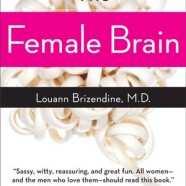
About four years ago, I read Tom Butler-Bowdon’s 50 Psychology Classics (2007); 50 seminal thinkers and their ideas, spanning over a century in time. Interestingly, the author includes a few contemporary “classics,” for which I’m grateful; in particular, Louann Brizendine’s The Female Brain (2006). In the past three or four years, there are few books I have recommended to my clients–both male and female–more than this book. On my office shelving, the book indeed looks like a “classic”, given the many readings and highlights I have devoted to it.
Dr. Brizendine is a neuropsychiatrist at the University of California, San Francisco, and founder/director of the Women’s Mood and Hormone Clinic. The reason I title this post “First, The Female Brain” is because her follow-up book in 2010, The Male Brain will be the subject of my next post in two weeks. Both books, basically, follow the same developmental outline: the girl (boy) brain, the teen girl (boy) brain, the brain in love, the mommy (daddy) brain, and the mature female (male) brain. Because human behavior is so biochemically directed, it behooves every person to understand its functioning–and implications–at these varied stages.
Here are a few chapter excerpts:
“By age two and a half, infantile puberty ends and a girl enters the calmer pastures of the juvenile pause. The estrogen stream coming from the ovaries has been temporarily stopped….When women talk about ‘the girl they left behind,’ this is the stage they are usually referring to. This is the quiet period before the full-volume rock ‘n’ roll of puberty. It’s the time when a girl is devoted to her best friend, when she doesn’t usually enjoy playing with boys” (p.23).
“The smooth sailing of girlhood is over. Now parents find themselves walking on eggshells around a moody, temperamental, and resistant child. All of this drama is because the girlhood or juvenile pause has ended, and their daughter’s pituitary gland has sprung to life as the chemical brakes are taken off her pulsing hypothalamic cells, which have been held in check since toddlerhood….It is the first time since infantile puberty that their daughter’s brain will be marinated in high levels of estrogen. In fact, it is the first time that her brain will experience estrogen-progesterone surges that come in repeated monthly waves from her ovaries. These surges will vary day to day and week to week…(becoming) even more sensitive to emotional nuance, such as approval and disapproval, acceptance and rejection” (pp. 32-33).
I love Dr. Brizendine’s advice to parents during this tumultuous time: “As a parent of teens, you have the job of ignoring much of what they say. Don’t take any impulsive or emotional tirades seriously….Just remember, your teen daughter’s impulsive-control circuits can’t handle the input. Like it or not, you must provide the control while her brain cannot” (52); obviously, easier said than done.
One more excerpt from later in the book – and in life:
“Fifty-one and a half years is the average age of menopause, the moment twelve months after a woman’s last period; twelve months after the ovaries have stopped producing the hormones that have boosted her communication circuits, emotion circuits, the drive to tend and care, and the urge to avoid conflict at all costs….With her estrogen down, her oxytocin is down, too. She’s less interesting in the nuances of emotions; she’s less concerned about keeping the peace….She’s not getting the calming oxytocin reward of tending and caring for her little children, so she’s less inclined to be as attentive to others’ personal needs” (p. 137). This is the reason Brizendine titles a subsequent section (articulated by many bewildered husbands): “Who Are You and What Have You Done With My Wife?”
In my book, the implications of all this – for personhood, parenthood, and partnerhood – are obvious. I highly recommend it!

